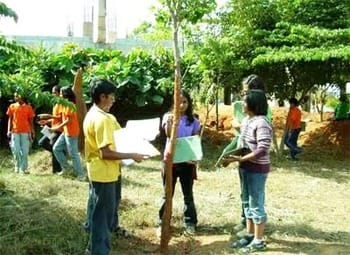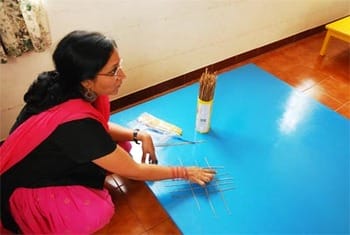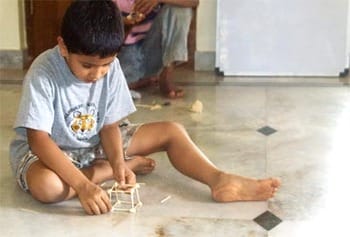ICSE, CBSE, IGCSE, IB, SSLC…If these seem like random combinations of letters to you, you probably do not have a child of school-going age. Most parents would instantly recognize these as abbreviations of the various school boards that exist in Bangalore today. In the quest of the perfect school for their child, parents of children as young as three begin to choose from among the plethora of not just schools but also school boards, each professing a different philosophy and vision.

Science is all around us: A biology class at Prakriya. (Pic: Prakriya)
With the majority of parents, the preferred board is one of the three Indian systems: ICSE, CBSE and SSLC (for full forms of abbreviations and basic details of the various boards, see box). Of these, the popular perception among parents is that the CBSE and ICSE curricula are tougher and more demanding than the SSLC curriculum.
How true is this? Rama Devi K, in her mid-fifties, was till recently a teacher with Aurobindo Memorial School, and has taught children in SSLC, CBSE and ICSE boards. She says that while all the three boards have similar syllabi in most subjects, the SSLC board’s curriculum has a more cursory coverage of subjects, while ICSE and CBSE tend to be more detailed.
For example, while SSLC books might devote a line each to various movements in world history, such as Nazism and Fascism, CBSE will have much more detail for every movement. Of the two Delhi Boards as they are often called, many parents pick CBSE over the ICSE because the former’s curriculum is more aligned towards the entrance exams, likely because CBSE also conducts the entrance examinations for admissions to engineering and medical colleges.
But entrance exams apart, opinions are divided on whether the CBSE or ICSE curriculum is more technical or of a higher standard. M Srinivasan, the fifty-something dynamic Founder Prinicpal of GEAR Innovative International School (CBSE) off Sarjapur Road, feels the CBSE syllabus is more technical. Others, such as IIM alumnus Seetha Ananthasivan, in her late fifties and currently Executive Trustee of Prakriya Green Wisdom School (ICSE), also off Sarjapur Road, feel ICSE’s is a more rigorous, “thinking syllabus” and vaster than CBSE’s.
With her experience of teaching in both systems, Rama Devi K agrees that ICSE is more ‘voluminous’. A comparison of a science subject’s syllabus between the two boards at the 12th Std. level shows that while the two are mostly identical, students are expected to know some topics in greater detail in ISC (the 12th Std. version of the ICSE) than in CBSE, while a few topics that are included in the CBSE syllabus do not figure in ISC’s syllabus.
However, all agree that while CBSE Hindi is of a far higher standard than ICSE, the latter’s syllabus is more holistic, giving equal importance to both technical subjects as well as to social sciences and languages. ICSE also lays much more stress on the English language and on English literature, perhaps reflecting its evolution from the Inter-State Board for Anglo-Indian Education, and the fact that its schools are largely urban, while CBSE caters to both urban and rural students.
But a reputation that dogs the SSLC and the two Delhi boards is that they encourage rote learning, or ‘by-hearting’, rather than any real understanding of the subject matter. Students who can memorise and reproduce the maximum information are rewarded with higher marks.
In addition to vast curricula, all the systems have a one-size-fits-all approach that does not recognise that students have different inclinations. ICSE’s move to make mathematics optional after the 8th is in recognition of the fact that mathematics, social studies and languages are problem areas for many children. The search for a less stressful alternative has led some schools such as Prakriya to give students the Open School option through the National Institute of Open Schooling (NIOS). Others have opted out of the CBSE/ICSE dilemma and opted instead for an international board.
Going international

Maths in the kitchen: Children use dough to learn about
three-dimensional shapes during a mathematics class at Shibumi. (Pic: Angela Jain, Shibumi)
Of the international boards available in Bangalore, the International General Certificate of Secondary Education (IGCSE) is the more popular. Indeed, this is also the world’s most popular examination at the 10th Std. level. Like the NIOS, IGCSE also allows students to do exams in stages so that children a less stressed. Roopa Devadasan, 42, who taught science at The Valley School (ICSE) off Kanakapura Road earlier and is now at Shibumi School (IGCSE) near Konanakunte, delineates other advantages: “The ICSE curriculum depends a lot on memory and its content has a limited role in understanding. The IGCSE syllabus is far more relevant and up-to-date, the examinations are structured such that they do not require rote learning, and the textbooks are far more interesting.”
With its huge variety of subjects (the board currently offers 67), even students not inclined towards the more usual science or mathematics are sure to find courses they find interesting and worthy of study. Shalini Sekhar, 21, currently working on her Bachelor’s degree while also teaching at Shibumi, wholeheartedly endorses this viewpoint. Inspired by Stephen Hawking and nurturing dreams of ‘understanding the universe’, she recently did both the ISC and A levels (12th Std. level of IGCSE) in physics. She describes her experience of the ISC as ‘quite painful’. “The examination tested very specific, isolated concepts and techniques in quite a bit of technical detail. I understood no physics at the end of it,” she says. A rather short period of studying preceded her A levels, at the end of which she says, though she could not claim to know physics inside-out, “I had started making connections between all the different concepts; I had formed a kind of structure within which I could understand physics.”
The other international board, the IB, is offered by only four schools in Bangalore, though more are on the anvil. The IB does not have an examination at the 10th Std. level. Forty-something Shouquot Hussain, a published poet and now Vice-Principal, Indus International School Sarjapur, says, “In India, most parents are not comfortable with just intangible benefits,” which is why Indus, and all other Bangalore IB schools, offer the IGCSE exam at the 10th Std level and the IB’s Diploma Programme (DP) examination at the 12th Std level.
Starting from this year though, Indus will have students do the IGCSE and obtain IB certificates at the 10th Std. level making it the only Bangalore IB school to offer the IB programme for children aged 3 to 18. The DP has a formidable reputation for rigour and for encouraging critical thinking and analysis, because of which, according to Hussain, “IB students who get more than a certain grade (equivalent to approximately 89%) do not need to do the SAT (Scholastic Aptitude Test) for US universities.”
To illustrate the difference from Indian boards, Hussain offers this example: “A student can start an essay on Shakespeare by saying Shakespeare is absolute trash, and he will not be penalised as long as he can substantiate his argument.” A unique aspect of the IB programme is its stress on non-academic activities. All children need to have logged at least 50 hours each of community service, sports and creative pursuits, such as dramatics, failing which they cannot qualify for the DP.
Although the agenda for most students who do the IB is to go abroad, not all who go through an international exam are necessarily heading westward. For a lot of parents, a concern is how relevant such education might be to India. Hussain agrees there is but little local content in IB’s DP curriculum. In history, for example, India appears only when events here were important from a global perspective. Thus colonialism, independence and Mahatma Gandhi figure prominently in the syllabus though Aurangzeb does not.
The situation is similar in the IGCSE, though the latter encourages students to give local examples and case studies in many subjects such as geography and sociology. Both boards, and hence most Bangalore schools, give students the option of studying Hindi.
Window of opportunity
Except for the IB which specifies a curriculum right from the nursery level, all the other school boards in Bangalore specify a curriculum only from the 9th Std. onwards. Innovative schools tend to use the period from the 1st to the 8th to expose children to the joys of learning. As Srinivasan of GEAR puts it, “Up to the 8th Std., education does not follow a board. This is when it should follow the child. It should be such that every child can enjoy it.”
At GEAR, for example, a lot of learning until the 8th Std. is activity and project based. Thus, starting from the 1st Std., in addition to a regular science class, children have a class called Hands-on Science, where they experiment with different materials and subjects discussed in the main science class. Similarly, a Whole Language class accompanies a Language class. “One is what CBSE wants, one is how it should be,” smiles Srinivasan. From 5th Std. onwards, children work on a different research project each year, researching any tree, personality, place or machine for an entire year recording data, gathering information, talking to experts in the field, and so on.
The school has introduced several small innovations, all targeted at encouraging children to think. For example, a huge chess board adorns the wall on one floor where children from one school house play against those from another. Children excitedly discuss moves and strategies amongst themselves before they go on to make some move. A chess board also sits outside every classroom for use during breaks. At assembly time, Srinivasan delights in challenging children with questions that demand out-of-the-box thinking.
Sample this: “Describe a conversation between two water bodies.” Or this: “Design a new water game, specifying rules for it.” The school also prides itself on its multiple-intelligence approach towards education, which essentially hypothesises that children learn things differently and have different propensities. Thus, children inclined towards visual learning would learn differently from those more attuned to verbal, logical or musical learning.

Mathematics with broomsticks: Teacher Sudha uses everyday
materials like broomsticks to teach children mathematical concepts like multiplication in her maths lab. (Pic: Meera Iyer)
At other schools like Prakriya, too, children use activity-based, experiential learning up to the 8th, the object being to bring together thinking, feeling and action, attributes that Seetha Ananthasivan feels the ICSE curriculum does not foster. For example, children at Prakriya recently built a pond in the school. In the course of the project, children learned mathematical concepts like perimeter, area and slope, and biological concepts like habitats for fish.
The school also tries to use thematic learning to encourage connections between subjects. For example, a water theme one year saw students learning about rivers in India, lakes in Bangalore, sea-level rise, the properties of water and so on. At Prakriya, children do not have examinations until the end of the 4th Std. because “We do not want to equate exams with learning,” says Ananthasivan. “Children have a lot of enthusiasm and are very responsive naturally, so we really try to maintain that, especially in the primary years and to certain extent in middle school,” she adds. But like other teachers of the Indian boards, she says that by the 9th Std., “We are more or less exam-focused.”
What is a good school?
So at the end of the day, what is it that makes a good school good? The consensus seems to be that rather than having a white board instead of a blackboard, or having air-conditioned school vans, what is critical is the staff. Beware of schools where teachers “lecture in the active voice if the textbook states something in the passive voice, and in the passive voice if the textbook gives it in the active voice,” says Rama Devi K.

Hard at work and enjoying it: A mathematics class in progress
at Shibumi.
Pic: Angela Jain, Shibumi
Most progressive schools spend a substantial amount of time and money on training. “If there is some latest research on how the brain functions, or on teaching methodology, shouldn’t we take it to the teachers?” asks Srinivasan rhetorically. Accordingly, at GEAR, every school term is preceded by a two-week workshop for teachers, with additional training programmes throughout the year.
Indus does something similar and also rewards committed teachers by making them stakeholders in the school, entitled to a share in profits after three years of service. Other schools like Prakriya have regular teacher workshops and encourage networking with teachers from similar-minded schools to promote an exchange of ideas. Besides regular teacher training programmes, Vidyaniketan (ICSE) also has exchange programmes whereby teachers spend a month abroad at associated schools in the UK, Japan or Singapore.
In sifting the grain from the chaff, one must look then, not towards the board, but towards a school’s commitment towards its teachers and their professional development.
Boards at a glance
|
|
CBSE |
ICSE |
SSLC & PUC |
|
Full form |
Central Board of Secondary Education |
Indian Certificate of Secondary Education (ICSE) |
Secondary School Leaving Certificate; Pre-University Course |
|
Exams organised by |
Central Board of Secondary Education |
Council for the Indian Certificate of Secondary Education |
Karnataka Secondary Education Examination Board; Dept of Pre-University Education |
|
Board HQ |
Delhi |
Delhi |
Bangalore |
|
Website |
www.cbse.nic.in |
www.cisce.org |
www.kseeb.org; pue.kar.nic.in |
|
10th Std. Exam called |
Central Board of Secondary Education |
Indian Certificate of Secondary Education (ICSE) |
Secondary School Leaving Certificate |
|
12th Std. exam called |
Central Board of Secondary Education |
Indian School Certificate (ISC) |
Pre-University Course (PUC) |
|
Marking |
Marks |
Grades & marks |
Marks |
|
Syllabus specified from |
9th |
9th |
9th |
|
Exams held |
Once a year |
Once a year |
Once a year |
|
Recognized by Indian Universities |
Y |
Y |
Y |
|
No of Bangalore schools following Board * |
102 |
103 |
776 (SSLC only |
Boards at a glance – continued
|
|
IGCSE |
IB |
NIOS |
|
Full form |
International General Certificate of Secondary Education |
International Baccalaureate |
National Institute of Open Schooling |
|
Exams organised by |
University of Cambridge International examinations; |
International Baccalaureate |
National Institute of Open Schooling |
|
Board HQ |
UK |
Switzerland |
Delhi |
|
Website |
www.nios.ac.in |
||
|
10th Std. Exam called |
International General Certificate of Secondary Education |
No exam in 10th Std. |
Secondary |
|
12th Std. exam called |
Advanced (A) level; Also has Advanced Subsidiary (AS) level equivalent to 11th Std. |
Diploma Programme (DP) |
Senior Secondary |
|
Marking |
Grades and marks |
Grades |
Marks |
|
Syllabus specified from |
9th |
Nursery |
9th |
|
Exams held |
Twice a year |
Once a year (for DP) |
Twice a year |
|
Recognized by Indian Universities |
Y |
Y |
Y |
|
No of Bangalore schools following Board * |
~30 |
4 |
~20 |
* Several schools such as Vidyashilp, Kumaran’s, Aurobindo Memorial, Prakriya and Mallya Aditi to name a few, offer more than one board. ⊕
Excellent article , this is great information for making a choice on schoold
Very Informative article.
Excellent article, very informative about the different boards
As a mother in search of a ‘good school’ this is an excellent and very informative article. Thank you!
Hi Meera,
Good story this! It definitely was an eyeopener and much needed information as well. Is there a method which rates the best of IGCSE, IB and NIOS Schools in Bangalore? GEAR, INDUS and SHIBUMI are all good schools. But if you are aware of schools with the best ratings, can you share it please?
Peace and Regards
Narayanan Vincent
While browsing, i came across your article.This is an informative post for parents. As i feel my child goes to Candor international school which follows IB,IGCSE curriculum.My eperience so far is very good..they have limited class size,experienced teahing faculties,lots of extra curricular activity and great academic result. http://www.candorschool.edu.in/
Hello.an excellent, detailed information about schools, boards,and their syllabi.Thanks a lot.May you succeed n prosper in all the servicing activities .